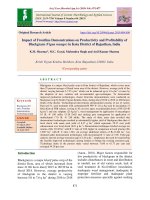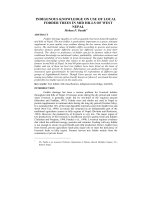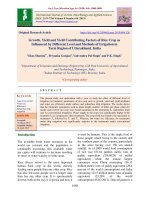Prevalence of gastrointestinal strongyles of goats in Mid Himalayas of uttarakhand, India
Bạn đang xem bản rút gọn của tài liệu. Xem và tải ngay bản đầy đủ của tài liệu tại đây (214.46 KB, 7 trang )
Int.J.Curr.Microbiol.App.Sci (2020) 9(3): 501-507
International Journal of Current Microbiology and Applied Sciences
ISSN: 2319-7706 Volume 9 Number 3 (2020)
Journal homepage:
Original Research Article
/>
Prevalence of Gastrointestinal Strongyles of Goats in
Mid Himalayas of Uttarakhand, India
M. Sankar1*, Vaishali2, M. Silamparasan1, V. Prasanth1, G. Siddharth1,
Ajayta1, Naincy Singh1, H. Agri1, V. Rai3 and S. Daria3
1
Indian Veterinary Research Institute, Mukteswar, Nainital, Uttarakhand, India
2
LUVASU, Hissar, India
3
Indian Veterinary Research Institute, Izatnagar, Bareilly, Uttarpradesh, India
*Corresponding author
ABSTRACT
Keywords
β-tubulin isotype-1,
Goats, PCR-RFLP,
Trichostrongyles
Article Info
Accepted:
05 February 2020
Available Online:
10 March 2020
Gastrointestinal nematodes (GIN) in ruminants are one of the major impediments in
livestock production and causes enormous economic losses. Accurate identification of GIN
is essential for studying epidemiology and envisage control programme. The present study
describes the generic composition of strongyle affecting goats of mid Himalayan
Uttarakhand by polymerase chain reaction based restriction fragment length polymorphism
(PCR-RFLP). The faecal samples (N=2231) of goats were collected from different places
of Uttarakhand over the period of three years (2016-2018) and screened for strongyle
infection by salt floatation. The positive samples were pooled subjected for larval culture.
The infective third stage larva obtained from the culture were used for PCR-RFLP using
RsaI restriction enzyme on β-tubulin isotype-I gene. The floatation results were indicated
that the strongyle infection was present throughout year and the intensity of infection was
moderate to severe from mid rainy season to autumn (Mid July to October). The
prevalence of GIN infection was 95.78% (2137/2231) and egg per gram was 1982±452.
The PCR-RFLP clearly differentiated three common strongyle species of goats such as
Haemonchus controtus, Teladorsagia circumcincta and Trichostrongylus colubriformis.
Based on PCR-RFLP, the predominant stronglye infections are H.contortus and T.
circumcincta in high altitude of Uttarakhand. The results obtained in the present study
suggest that the GIN infection is common among goats of mid Himalayan region of
Uttarakhand and further it enlighten on timely intervention before the development of
clinical disease.
reduced reproductive efficiency, stunted
growth and predisposing for other infections
(Waller, 2006). If the infection persists
without any intervention, GIN can cause
significant losses in animal production,
ranging from reduced body weight to the
Introduction
Livestock agriculture is subject to severe
economic losses from gastrointestinal
nematodes (GIN) infections, in the form of
direct losses due to blood and tissue feeding,
501
Int.J.Curr.Microbiol.App.Sci (2020) 9(3): 501-507
death of the animals, particularly young stock
(Soulsby, 1982). The major species of
nematodes infecting the GI tract of ruminants
belong to the family Trichostrongylidae. The
economically important trichostrongyles of
small ruminants in tropical and sub-tropical
regions like India are Haemonchus contortus,
Trichostrongylus spp., Oesophagostomum
spp. and Bunostomum trigonocephalum.
Materials and Methods
Sample collection
The present study was carried out on grazing
goats in the districts Almora, Nainital,
Champawat,
Pithoragarh,
Bageshwar,
Uttarakasi and Rudraprayag of Uttarakhand.
These areas are coming under the mid
Himalayan region of Uttarakhand. The faecal
samples of goats were collected randomly
from both sexes and different age groups of
goats over the period of three years (February
2016 to December 2018) in all seasons
[spring (March to June), monsoon (July to
September), autumn (October to November)
and winter (December to February)]. The
samples were collected per rectum in labeled
containers and processed in the laboratory.
In temperate region, addition to above four
species,
Teladorsagia
circumcincta,
Chabertia ovina and Nematodirus spp., are
also pose a major threat to successful
livestock production (Dhar et al., 1982;
Waller, 2006; Tariq et al., 2008, 2010;
Annual report, GIP, 2014).
The strongyle infection in ruminants is
acquired by ingesting grasses contaminated
with third stage infective larvae (L3). The
eggs or larvae of these species cannot be
differentiated accurately; therefore proper
identification is must for epidemiological
aspects and formulation of control strategies
(Gasser et al., 2009).
Parasite examination
The occurrence and intensity of infection was
determined by qualitative (salt floatation)
method (Soulsby, 1982). The positive samples
were subjected for modified McMaster
method for quantification of parasitic eggs
(MAFF, 1977; Soulsby, 1982; Fowler, 1986).
The microscopy positive faecal samples were
pooled based on location and subjected for
faecal culture to obtain infective third stage
larvae.
The polymerase chain reaction linked random
fragment length polymorphism (PCR-RFLP)
on ribosomal genes (Hoste et al., 1998) and βtubulin (Silvestre and Humbert, 2000) have
demonstrated for accurate identification
trichostrongyles. A detailed survey is
essential to understand the implication of
gastrointestinal nematodiasis in goats of mid
Himalayan Uttarakhand.
DNA isolation
The genomic DNA from single larva was
extracted based on the method employed by
Silvestre and Humbert (2000) and Chandra et
al., (2015). In short, the infective larvae
obtained from the culture were cleaned 3-4
times with distilled water and were
exsheathed by sodium hypochlorite (aqueous
solution, 3.5% active chlorine). Single
exsheathed larva was picked by using
micropipette in a PCR tube and digested by
adding 5 l of digestion buffer (50mM Tris-
Currently, very little data exist for nematode
infections of ruminants mainly based on
morphological identification method. The
paucity of data has necessitated this study
with primary objective to provide data on
prevalence of gastrointestinal strongyles of
goats of mid Himalayan Uttarakhand in
different seasons.
502
Int.J.Curr.Microbiol.App.Sci (2020) 9(3): 501-507
HCl, 10mM EDTA and 5 mg/ml proteinase
K). The larva was incubated at 56 ºC for 4
hrs. The lysate was further incubated at 99ºC
for 20 minutes to inactivate Proteinase K.
Results and Discussion
A total of 2231faecal samples were screened
by salt floatation and faecal egg counts
(EPG). The results were indicated that the
endoparasitic
infection
was
present
throughout year (2137/2231, 95.78%) in mid
Himalayan region of Uttarakahnd and EPGs
were in the range from 500-11460 (mean EPG
1982±452). The peak EPG was observed
during and after monsoon. However, mild
infections were maintained also in winter
months (December to February). In
agreement with present study, Ram et al.,
(2007) also reported overall GIN prevalence
of 93.86% in goats of Uttarakhand.
Primary PCR amplification of -tubulin
isotype 1 gene
Genomic DNA from third stage larvae (5 µl)
was used as template for amplification of tubulin isotype-1 gene in reaction mixture of
25 µl containing 10 pmol of each primers
(Pn1- 5′ GGC AAA TAT GTC CCA CGT
GC 3′ and Pn2- 5′ GAT CAG CAT TCA GCT
GTC CA 3′), 200 µM of each dNTPs, and 1U
of Taq DNA polymerase. Polymerase chain
reaction was performed at initial denaturation
at 98 ºC for 2 min, then 20 cycles of 98 ºC for
15 s, annealing temperature of 57 ºC for 30 s,
68 ºC for 1min, then a final step at 68 ºC for
10 min. PCR products were used as template
for nested PCR.
The nested PCR amplicon size was 774 bp
(Fig.1) and the RsaI RFLP digested fragments
of H. contortus showed major fragments of
441 bp, 190 bp and 155 bp, T. colubriformis
revealed fragments of 395 bp, 177 bp and 98
bp and Te.circumcincta showed fragments of
284 bp, 182 bp and 132 bp (Fig.2). These
banding patterns clearly differentiated
commonly infecting GINs of goats in
Uttarakhand. Earlier studies showed PCRRFLP on ribosomal genes such as internal
transcribed spacer 1 and 2 (ITS-1 and 2)
(Hoste et al., 1998; Heise et al., 1999) and βtubulin isotype 1 (Silvestre and Humbert,
2000) are very powerful tool for
trichostrongyle species differentiation. The
results of PCR-RFLP revealed that H.
contortus (41-54%) and Te.circumcincta (2437%) were the most common strongyle in
goats of Uttarakhand, invariably from all
districts (Table.1). However, other nematodes
Trichostrongylus
spp
(9-13%),
Oesophagostomum spp (7-14%) were also
recorded. Earlier reports demonstrated GINs
common in goats of Uttarakhand (Yadav et
al., 2008; Subramani et al., 2014).
Nested PCR
One µl of primary PCR products were used as
template for nested PCR. The final reaction
mixture of 25 µl is containing 10 pmoles of
each primer (Pn3- 5 GGA ACA ATG GAC
TCT GTT CG 3′ and Pn4- 5′ GGG AAT CGA
AGG CAG GTC GT 3), 2.0 mM MgCl2, 200
µM of each dNTPs, and 1U of Taq DNA
polymerase. Polymerase chain reaction was
performed at initial denaturation at 98 ºC for 2
min, then 33 cycles of 98 ºC for 15 s,
annealing temperature of 57 ºC for 30 s, 68 ºC
for 1 min, then a final step at 68 ºC for 10
min.
RFLP with RsaI enzyme
For species identification, 10 µl of of nested
PCR product was digested with restriction
enzyme RsaI for 1.5 h at 37ºC. The digested
amplicons were resolved in 2.5% agarose gel
electrophoresis and documented.
The highest infection was observed during
monsoon and post monsoon sessions (Fig. 3
503
Int.J.Curr.Microbiol.App.Sci (2020) 9(3): 501-507
and Table 2), however, mild infection was
maintained during winters. This pattern can
be assigned to variation in the rainfall and
temperature in the weather that favors the
spurt of infective larvae in the environment
during monsoon (Soulsby, 1982; Taylor et al.,
2015). PCR-RFLP using RsaI on β-tubulin
isotype -1 gene showed higher prevalence of
H. contortus and Te. circumcincta and
moderate infection of Oesophagostomum spp
and Trichostrongylus spp. The prevalence of
strongyles were lowest in the winter months
followed by spring that might be due to
hypobiosis of larvae in the host thus, less
number of infective larvae in the pasture.
Earlier study found that heavy infection of
haemonchosis on goats of high altitude of
Uttarakhand (Ram et al., 2007) which is well
corroborating with present study. The study
concluded that GINs are very common and
chronic debilitating disease of goats in
Uttarakhand. The present study findings
enlighten
further
to
determine
epidemiological pattern of GIN infection and
formulation of control strategy.
Table.1 Various GIN infection in goats from different districts (in %)
Places (no. of larvae) H. contortus T. colubriformis T.circumcincta
44
54
47
43
51
41
42
Almora (470)
Nainital (871)
Pithoragarh (92)
Champawat (81)
Bageshwar (74)
Uttarakasi (56)
Rudraprayag (63)
10
13
11
9
11
13
12
32
24
30
34
31
37
37
Others (mainly
Oesophagostomum spp)
14
09
12
14
07
09
09
Table.2 Season wise GIN infection in goats
Season
Teladorsagia
circumcincta
Haemonchus
contortus
Trichostrongylus
spp
Others (mainly
Oesophagostomum
spp)
Winter
37-44%
31-36%
12-13%
20-22%
Summer
18-21%
56-64%
11-13%
13-16%
Rainy
19-23%
55-67%
14-16%
07-10%
Autumn
16-20%
40-47%
10-13%
20-23%
504
Int.J.Curr.Microbiol.App.Sci (2020) 9(3): 501-507
1
2
3
M
4
5
6
7
Fig.1 Results of nested PCR amplification of beta tubulin isotype 1 gene
Lane M- 100 bp plus Marker Lane 1-7: Nested PCR amplicons (774 bp)
M
1
2
3
Fig.2 Results of PCR-RFLP for species identification
Lane 1- 100 bp plus Marker
Lane 2- H. contortus (441bp, 190bp, 155bp)
Lane 3- T. columbianum (395bp, 177bp, 98bp)
Lane 4 – T. circumcincta (284bp, 184bp, 132bp)
505
Int.J.Curr.Microbiol.App.Sci (2020) 9(3): 501-507
Fig.3 Monthly prevalence of common GIN of goats
Fowler, M.E., 1986. Zoo and Wild animal
medicine. 2nd ed. W.B.Saunders
Company, Philadelphia. pp: 700-701.
Gasser, R. B., de Gruijter, J. M., and
Polderman, A. M., 2009. The utility of
molecular methods for elucidating
primate-pathogen relationships the
Oesophagostomum bifurcum example.
In M. A. Huffman & C. A. Chapman
(Eds.), Primate parasite ecology: the
dynamics and study of host-parasite
relationships. Cambridge: Cambridge
University Press. pp: 47–62.
Heise, M., Epe, C. and Schnieder, T.
Differences in the second internal
transcribed spacer (ITS-2) of eight
species of gastrointestinal nematodes of
ruminants. The J. Parasitol., 85(3): 431435.
Hoste, H., Chilton, N.B., Beveridge, I. and
Gasser, R.B. 1998. A comparison of the
first internal transcribed spacer of
ribosomal DNA in seven species of
Trichostrongylus.
(Nematoda:
Trichostrongylidae). Int. J. Parasitol.
28: 1251-1260.
MAFF, 1977. Manual of Veterinary
Parasitological
Techniques.
In:
Acknowledgement
The authors are highly thankful to Indian
Council of Agricultural Research (ICAR)
New Delhi, India for funding through AICRP
on goat improvement, Project Coordinator of
AICRP and Director of Indian Veterinary
Research Institute, Izatnagar, India for
providing facilities for research.
References
Annual Report, Network project on
gastrointestinal parasitism (GIP), ICARIVRI, 2014.
Chandra, S., Prasad, A., Yadav, N.,
Latchumikanthan, A., Rakesh, R.L.,
Praveen, K., Khobra, V, Subramani,
K.V., Misri, J. and Sankar, M. 2015.
Status of benzimidazole resistance in
Haemonchus contortus of goats from
different geographic regions of Uttar
Pradesh, India. Vet Parasitol. 208 (34):
263-267.
Dhar, D.N., Sharma, R.L. and Bansal, G.C.
1982. Gastrointestinal nematodes in
sheep in Kashmir. Vet.parasitol. 11 (12): 271-277.
506
Int.J.Curr.Microbiol.App.Sci (2020) 9(3): 501-507
Helminthology, Technical bulletin
no.18. Ministry of Agriculture, London,
UK
Ram, H., Sharma,A.K., Singh, S.K.,
Meena,H.R. and Rasool, T.J. 2007.
Seasonal nematode egg output in goats
at high altitude of Uttarakhand, India. J.
Vet. Parasitol. 21(1): 73-74.
Silvestre, A. and Humbert, J.F. 2000. A
molecular tool for species identification
and benzimidazole resistance diagnosis
in larval communities of small ruminant
parasites. Exp. Parasitol. 95: 271-276.
Soulsby, E. J. L. 1982. Helminths, Arthropods
and
Protozoa
of
domesticated
animals.New-Delhi First East-West
Press.7thEdition 2012. PP. 206-252.
Subramani, K.V., Sankar, M., Prasad, A.,
Gowane., G.R., Sharma,A.K., Zahid,
A.K., Saravanan, B.C., Khobra, V. and
Chandra, S. 2016. Evaluation of
Kumaon hill goats for resistance to
natural infection with gastrointestinal
nematodes. J. Parasit Dis. 40(2): 539542.
Tariq, K.A., Chishti, M.Z. and Ahmad, F.,
2010.
Gastro-intestinal
nematode
infections in goats relative to season,
host sex and age from the Kashmir
valley, India. J. Helminthol. 84:93–97.
Tariq, K.A., Chishti, M.Z., Ahmad, F. and
Shawl, A.S. 2008. Epidemiology of
gastrointestinal nematodes of sheep
managed under traditional husbandry
system in Kashmir valley. Vet.
Parasitol. 158:138–143.
Taylor, M. A., Coop, R. L. and Wall, R. L.
2015. Veterinary Parasitology, 4th
Edition, Wiley Publications. United
States.
Waller, P.J. 2006. Sustainable nematode
parasite control strategies for ruminant
livestock by grazing Animal. Feed Sci.
Technol. 126 (3–4): 277-289.
Yadav, C.L., Kumar,R.R., Garg,R., Vatsya, S.
and Banerjee, P.S. 2008. Epidemiology
of gastrointestinal nematodosis in goats
of Uttarakhand, India. Indian J. Anim.
Sci., 78(12): 1370-1372.
How to cite this article:
Sankar. M, Vaishali, M. Silamparasan, V. Prasanth, G. Siddharth, Ajayta, Naincy Singh, H.
Agri, V. Rai and Daria. S. 2020. Prevalence of Gastrointestinal Strongyles of Goats in Mid
Himalayas of Uttarakhand, India. Int.J.Curr.Microbiol.App.Sci. 9(03): 501-507.
doi: />
507









